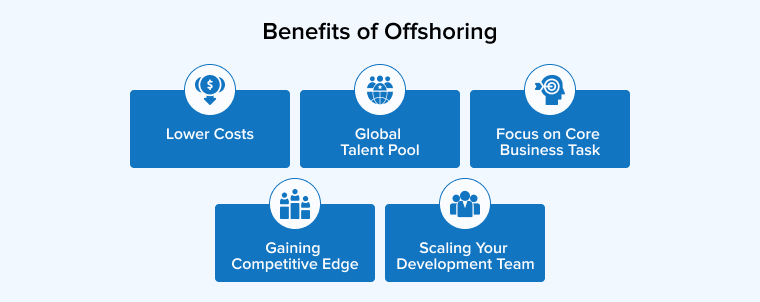
Both offshore and nearshore terms refer to the practice of outsourcing your software development project to a company, vendor, or individual residing in or operating from another country. You need to hire a reliable offshore software development company when your in-house team lacks the expertise to fulfill your IT requirements. Hiring developers from neighbouring countries is referred to as nearshore development, whereas offshore development means collaborating with vendors in distant regions.
It is up to you to decide which model best suits your project and business. To help you make an informed decision, this blog offers a detailed comparison between nearshore and offshore models, with a thorough examination of their respective risks and benefits.
1. Concept of Nearshore Software Development
The practice of outsourcing software development projects to developers in nearby countries is known as nearshore software development. In this model, the client’s and vendor’s countries share the same time zone or differ by no more than 3 hours.
Sharing the same time zone, or having only a small difference, allows for easy, real-time communication between clients and the development team. You don’t have to spend long hours on a flight for in-person meetings and project discussions.
This way, businesses can hire global tech expertise while keeping the time gaps to a minimum and eliminating any communication barriers.
1.1 Benefits of Nearshoring
Nearshore development offers a mixture of both onshore and offshore benefits. Here are a few of the nearshore software development benefits:
1. Similar Time Zones
Working in a different time zone poses a significant challenge for business collaboration. Teams at least need some overlapping time to properly coordinate and communicate with each other. The lack of that overlap forces one team to work extra hours. Nearshore outsourcing solves this problem since the time difference between the two locations is easily manageable. Outsourcing to a company with a similar time zone makes traveling easy in case the project demands on-site visits and in-person meetings with your development team.
2. Access to Skilled Talent
Nearshoring offers businesses a chance to hire talented individuals from nearby locations. Some software development projects demand specific knowledge and expertise that can often be lacking or in low supply in a local region.
Widening the scope of search to hire talented individuals on a nearby shore enables businesses to work with domain experts and highly experienced IT professionals without spending much time and effort on recruitment and training programs.
Meanwhile, experts from nearshore are already familiar with the trends of the industry in the local as well as the global market. They can maintain the perfect balance between the two, helping businesses stay ahead in the competition.
Nearshore developers are often also familiar with the local languages, so the chances of miscommunication are also low. You get to hire experts who know and speak your language. This makes the communication and collaboration seamless, ensuring effective outcomes.
3. Better Control Over Projects
When outsourcing a project to an offshore company, the business or management team can rarely visit the site and exercise control over their project. In the nearshore, the teams can easily visit the site or have their team visit the company office. This is extremely important from the perspective of building lasting business relationships, addressing issues in real time and ensuring that all deliverables meet their deadlines.
The close proximity between both locations allows the business to conduct regular check-ins, monitor the work and progress closely, and provide real-time feedback. Such a granular level of control is helpful for a business that has to shift quickly in response to market dynamics or changing business requirements. Having better control over the project helps foster adaptability and innovation with agility.
4. No Language Barriers
The geographical and cultural proximity to your nearshore partner enhances communication effectiveness and smoothness.
Your communications will not be misinterpreted, eliminating the need to stay awake until dawn awaiting a reply from a coworker hundreds of kilometers away. The majority of nearshore activities are located within the time zones of the main headquarters.
In addition, the shorter distance between your offices and your expanded staff allows for more regular in-person meetings and collaborative activities. This enhances cooperation, creates a spirit of teamwork, and promotes a genuine sense of ownership in the business culture.
1.2 Risks of Nearshoring
Despite many advantages, you may also experience various challenges when adopting a near-shore software development model.
1. Higher costs
Nearshore is more expensive than offshore because it hires developers in similar time zones. Neighboring countries often share comparable economic structures, so rates may be similar to hiring an in-house development team or just a little less. However, nearshore costs are typically higher than offshore options in countries with high economic feasibility and competitive rates. In addition, there can be hidden costs such as regulatory compliance, legal fees, on-site visit expenses, and more.
2. Quality Assurance Concerns
Differences in work culture and standards may lead to quality concerns during nearshore software development. You don’t have the same level of control over quality as with in-house teams. Limited oversight and the lack of on-site presence can allow development teams to deviate from strict adherence to QA protocols. As a result, the risks of non-compliance, defects, quality issues, and customer dissatisfaction increase.
2. Concept of Offshore Software Development
In offshore software development outsourcing, companies delegate the software development process to an international contracting organization. In contrast with a near-shore team, offshore developers are located in different regions. Popular offshore destinations include Latin America, India, Ukraine, and China. The global offshore software development market size is expected to be worth around USD 389.7 billion by 2033, from USD 120 billion in 2023, growing at a CAGR of 12.5% during the forecast period from 2024 to 2033.
2.1 Benefits of Offshoring

Offshore software development is considered one of the most beneficial approaches. Let’s take a look at some of the advantages it offers:
1. Lower Costs
Developing software is an expensive process, so it’s important to manage your budget wisely. When outsourcing a project to a software development company, your primary objective is to obtain a superior result, but you should also consider the financial sustainability of this strategy. As stated previously, programmers from underdeveloped nations cost less than their American counterparts.
Programmers based in the United States and Western Europe typically charge between $60-$200 per hour, but skilled professionals from India would charge approximately $40 per hour; therefore, you will save a portion of your budget with this strategy.
2. Global Talent Pool
The average organization invests 10 weeks or longer searching for a software development team. Upon reflection, this represents 2 to 3 months of time and money lost. The need for expert programmers is considerable, yet it is difficult to locate local talent.
With offshoring, you will be exposed to universal offshore software development services. Offshore destinations like India, Ukraine, and the Philippines possess software developers with excellent technical skills.
3. Focus On Core Business Task
Outsourcing software development can save your business considerable time. This is particularly relevant for startups with small teams that are constantly switching between their key business responsibilities. Micro startups typically have limited funds; therefore, outsourcing is an excellent choice for them.
When your organization has rapid access to skilled professionals and experienced offshore development teams for your technological division, you and your team can focus on other crucial business-related activities with relative ease. While managing an in-house team requires constant monitoring, a competent outsourcing partner will complete your duties by the specified deadline.
4. Gaining Competitive Edge
Utilizing new technology is becoming increasingly vital for organizations today. Trends in the IT industry, such as Business Intelligence (BI), Artificial Intelligence (AI), Machine Learning (ML), Robotic Process Automation (RPA), and Blockchain, among others, have become the main source for simplifying global corporate processes.
Nevertheless, implementing these technologies can be difficult; hence, companies regularly outsource their development tasks to offshore software development firms with experience in such software technologies. This helps them achieve a competitive edge in their respective industries.
5. Scaling Your Development Team
Any company’s development path will require scaling up or down its resources. A software development project does not always require the same assets throughout its lifecycle. There are times in project development when a large number of IT professionals are required. When production reaches a particular level, it may be necessary to reduce the size of the development team.
By delegating your development work to an offshore development center, you can save significant time, money, and effort in building your development team. After forming a partnership, the development team will effectively work for you. However, the offshore corporation will be in charge of the development staff. In other words, they will allow you to request additional employees or reduce the number of resources based on your needs.
2.2 Risks of Offshoring
There is no such thing as a perfect software development model. Each approach has its own set of pros and cons. Here are a few limitations of offshoring:
1. Time Zone Differences
The time zone difference is one of the most significant difficulties that come to mind when considering working with someone in a distant nation. When dealing with a company, there is often a significant time difference between you and your staff, who will work while you sleep and vice versa. As a result, communication can be delayed. If you require explanations or wish to contact your offshore team, you will have to wait until their shift begins for a response, which might cause additional delays in the project’s completion.
Traveling to your partner’s place requires both time and money. If you and your project place a high value on frequent and timely communication, offshore outsourcing may not be the ideal solution.
2. Poor Communication
In the offshore development model, the client and the vendor may be from countries with different native languages. If they don’t share a common language, such as English, communication is impossible. In other cases, English is not the primary language of the vendors.
With poor proficiency in the language, there might be miscommunication and incorrect assumptions. This could lead to mistakes and delays in the project, which might be expensive to correct. Moreover, lacking clear communication channels, protocols, and timelines can cause confusion and other issues.
3. Security Concerns
Outsourcing a project includes giving the vendor access to sensitive business and user information. If the offshore provider lacks proper security measures, the risk of data breaches or theft increases. This can damage your brand reputation and could lead to significant financial losses.
Businesses must implement necessary measures to ensure the security of their data and IP. Additionally, sign an NDA with your vendor to prevent them from sharing your business and project information with their partners, beneficiaries, etc.
3. Nearshore vs Offshore Software Development: Which is Better?
This isn’t about which approach is better, but about which approach is best suited to your project. Let us compare our options against common parameters to determine the ideal use cases for these software development approaches.
3.1 Cost Efficiency
Nearshore services are often cheaper compared to local hiring, but they are certainly more expensive than offshore development. Having a development partner in proximity helps keep logistical costs low and ensures better collaboration.
However, opting for offshore can help businesses to save up to 50% or more, making it the most affordable option. Offshore locations have low labor costs, allowing you to make the most out of your investment without compromising on quality. Businesses must also look out for hidden costs in whatever approach they select by clarifying the deliverables and expenses beforehand.
3.2 Access to Talent
Looking for a talented developer in your neighbourhood is different from searching across a vast, far-off horizon. The chances of accessing a large talent pool with the required expertise are very low when opting for nearshore development.
On the contrary, widening the search can lead you to countries like China, India, and the Philippines, where tens of millions of technical professionals enter the workforce each year.
You can easily find candidates with the required expertise or skill sets from offshore destinations at competitive rates.
3.3 Communication
Communication is critical for successful collaboration. Any miscommunication, poor communication, or lack of communication can result in various types of issues and losses.
In offshore development, teams often face language and cultural barriers in addition to large time zone differences. While this isn’t true for every offshore destination, many offshoring projects do experience problems such as delayed responses. Using communication tools like Skype and Teams helps teams collaborate with the remote project team.
Meanwhile, most nearshore companies don’t face significant cultural or language barriers and operate in similar time zones, which reduces communication challenges. Nevertheless, teams on both sides still need to clearly define requirements and raise concerns to achieve effective outcomes.
3.4 Cultural Aspect
Cultural differences affect the smooth and efficient working of the project. A project can be derailed if teams on both ends follow different work cultures. For example, if the business wants to work in an agile environment but the vendor is still sticking to a more rigid, plan-driven approach, they will struggle to meet client requirements.
Similarly, if the client’s requirements can be easily satisfied through a static culture, then pushing for agile would plunge them into unnecessary costs. Cultural aspects refer to the team’s working approach and their business ethics.
Offshore companies mostly differ in cultural aspects. Coming from another part of the world, they bring different work ethics and approaches. However, if a vendor has been serving in the IT field for a while now, then they can easily grasp the requirements of the client and align their workflow to find a suitable solution.
On the other hand, nearshore companies often share several cultural alignments, but that doesn’t mean they are always the right fit for business collaboration. Check which values the company prioritizes and what ethics its team follows before handing your project to any vendor. The project will run smoothly if their workflow aligns with yours.
3.5 Geographical Proximity and Time Zones
In terms of geographical proximity and time zone, nearshore countries have a benefit. They work with minimal time-zone differences, allowing for faster response times and quick collaboration. For example, a business from the US outsourcing its software development project to a company in Canada can easily schedule meetings in the overlapping business hours. They can communicate throughout the day, discussing the project and exchanging updates.
However, the offshore companies are located in regions with a time zone difference of several hours. For example, an India-based developer may be 10 hours ahead of a New York-based client. As a result, scheduling meetings and having real-time communication can be difficult. Information exchanged through text messages and email can also have delayed responses. Communication is the biggest issue in offshoring because the office hours don’t overlap, forcing either team to work overtime or in double shifts.
4. Nearshore vs Offshore Development: A Quick Comparison
We discussed the difference between offshore and near-shore development approaches in detail. This section adds a few more parameters to the discussion and gives a bird’s-eye view of their comparison.
| Criteria | Nearshore outsourcing | Offshore outsourcing |
|---|---|---|
| Travel possibilities | Max up to 5 hours duration by flights | 30-hour flights with additional expenditures for sleeping accommodations |
| Real-time collaboration | Only possible for regions with the same time zone | Harder to organize owing to 7- to 10-hour time zone disparities |
| Cultural similarity | Very identical | The majority of offshore outsourcing locations are in Asia and Africa, both of which have civilizations radically distinct from North America. |
| Project safety | The WTO, WIPO, PCT, and USMCA accords | Some contracts are not applicable |
| Project costs | $25 – $50/hr | $15 – $100/hr |
| Perks |
|
|
5. Conclusion
In today’s economic environment, outsourcing professional developers to an offshore software development company can be a smart strategic choice for any company seeking to grow and reap long-term rewards.
Building an in-house development team or outsourcing your project to a foreign business company both have their downsides. Nonetheless, the advantages of collaborating with offshore software development businesses would have a favorable impact on spending, productivity, and the ability to expand your organization. Their skills, experience, and specialty in technology would guarantee that your project employs the newest and most popular technologies.
In addition, you may focus on your main business while your offshore software development partner optimizes the technical components.






Comments
Leave a message...